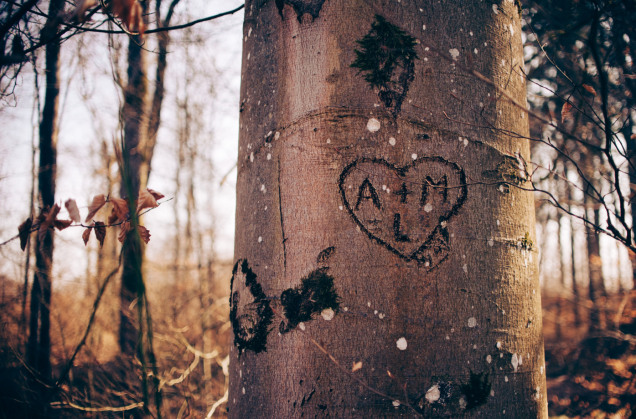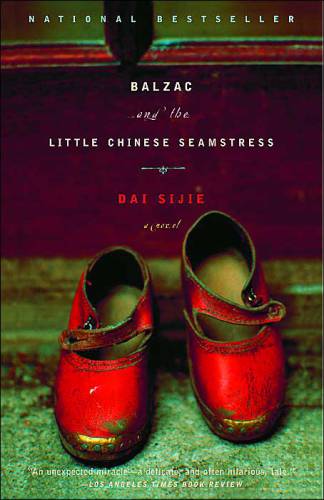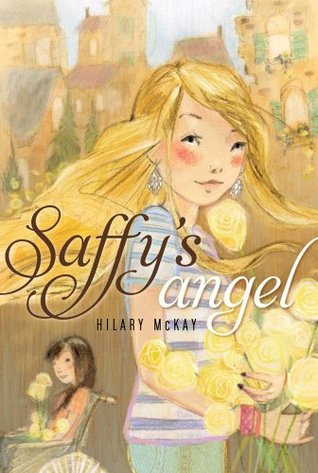Today, along with the rest of the country, the School will mark the sacrifice made by those who have given their lives in war. A poppy wreath will be laid after a service in the Chapel and The Last Post will be sounded.
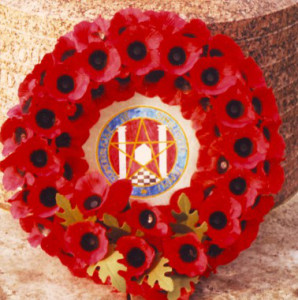
(The School will then differ from most organisations as this will be followed by a performance of Drill, at the end of which every one of the 180 girls will leave a poppy in her place as she marches from the Hall. For more about Drill, see http://www.rmsforgirls.org.uk/userfiles/rmsmvc/documents/AboutUs/History%20Trails/Drill%20history.pdf)
The idea of Remembrance Sunday was born in 1921. The date of the 11th November for Armistice Day honours the official ending of the First World War on the eleventh hour of the eleventh day of the eleventh month. The Royal British Legion was founded on 15 May 1921 but the Poppy Day idea started with Madame Anna Guérin.
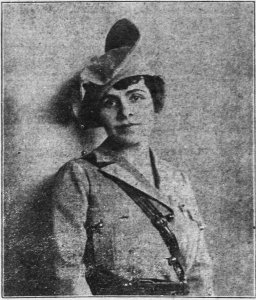
Image from https://www.pinterest.com/pin/359443613995900209/
“After taking her idea to Field Marshal Douglas Haig and the British Legion, Madame Guérin’s poppies (made by the widows and orphans of the devastated areas of France) were distributed on British streets on 11 November 1921 – on the country’s first Poppy Day.” https://poppyladymadameguerin.wordpress.com/remembrance-poppy-timeline-for-great-britain/
The Tamworth Herald in 1921 informed the public “They are made in two qualities – in silk and in mercerised cotton.”
The poppy was chosen as the emblem inspired by the poem In Flanders Fields written by Canadian physician, Lieutenant Colonel John McCrae, in 1915 after witnessing the death of his friend.
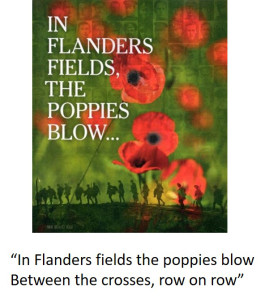
The poppies are made “at the Richmond poppy factory … [which] has employed disabled ex-servicemen to construct the huge number of poppies needed every year.” https://britishpathe.wordpress.com/2012/10/31/poppies-an-illustrated-history/. By 1968, the factory had 300 staff and manufactured 13 million poppies per annum and today approximately 36 million are produced, albeit with more automation and therefore fewer employees. “A team of about 50 people—most of them disabled former British military personnel—work all year round to make millions of poppies at the Poppy Factory in Richmond” (Wikipedia). So, like Santa’s elves, the work is endless for a single day event.
The poppies in UK (apart from Scotland, see below) “typically have two red paper petals mounted on a green plastic stem with a single green paper leaf and a prominent black plastic central boss” (Wikipedia). Until 1994, this boss had the words Haig’s Fund stamped on it whereas today it has the words ‘Poppy Appeal’. The introduction of the words had originally been because fraudulent poppy sellers – there’s always some who try to make a fast buck from a good cause – were selling poppies to the public but pocketing the money. The ‘Haig’s Fund’ stamp of authority, plus an official badge worn by the sellers, sought to eliminate the fraud.
These days “It has become common to see large poppies on buses, tube trains and aeroplanes as well as on lampposts, billboards, public buildings and landmarks” (Wikipedia) and internet sites and social media also display them.

 The top image needs no explanation, the lower image is a composite made from Ancestry.co.uk and FindMyPast.co.uk, both family history sites.
The top image needs no explanation, the lower image is a composite made from Ancestry.co.uk and FindMyPast.co.uk, both family history sites.
In 2014, to mark the centenary of the Great War, the Tower of London installation comprised 88,246 ceramic poppies, one poppy for each British or Commonwealth soldier killed.
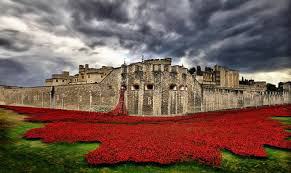
(Image from https://bwi.forums.rivals.com/threads/june-28th-1914-102-years-ago-today-the-great-war-aka-world-war-i-began.125052/)
The School did their own version of this for the Chapel for Remembrance Day in that year.
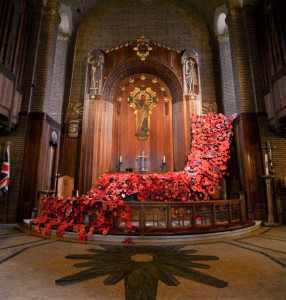
Debate arises every year about ‘poppy etiquette’ and some see it as a political symbol. The Football Association caused a furore in 2016 by fining the players wearing one, claiming it was a political symbol the wearing of which was forbidden by their rules. In 2017, they changed those rules. They weren’t going down that route again! There are arguments about when you start wearing your poppy, arguments about whether it should be on the left (near the heart and where medals are worn) or men on the left and ladies on the right, arguments about whether it is significant that the leaf points towards 11 o’clock or not. This last isn’t a problem in Scotland where the poppies don’t have a leaf. This is because they are made by PoppyScotland rather than the Royal British Legion and they have four petals rather than the two favoured by the RBL. There’s also a white poppy “first introduced by the Women’s Co-operative Guild in 1933 and now sold by the Peace Pledge Union.” http://www.bbc.co.uk/newsbeat/article/41942346/remembrance-poppy-controversies-and-how-to-wear-it. It symbolises an opposition to war and a commitment to lasting peace.
However, controversies aside, for poppies to be worn or not, there have to be those that organise the Poppy Appeals, to say nothing of the countless thousands of volunteers who stand out in the cold or in draughty shop doorways enabling the rest of us to buy our poppies. And it is here that we turn to another connection between the School and Remembrance Sunday. William Henry Keppy 1895-1941 is recorded in the 1939 register as Managing Secretary Poppy Day Appeal Fund.
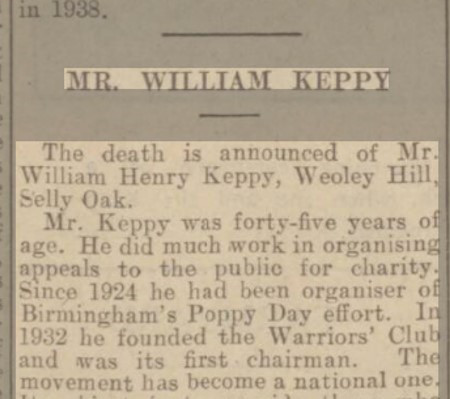
As the Birmingham Daily Post of 6 January 1941 (above) indicates, he was also involved in a number of other charities as secretary or organiser. Given that Poppy Day started in 1921, for Mr Keppy to have been involved in its organisation from 1924, and that he founded the Warriors’ Club (now, sadly, vanished without trace), the notion of remembrance was clearly important to him. His father had been a soldier (Company Sergeant-Major South Wales Borderers and awarded the DCM) and assisted his son with the Warriors’ Club. William himself served throughout WWI, first joining the Warwickshire Yeomanry in 1913. He was discharged in 1919 but re-enlisted in 1921. Although he appears to have escaped unscathed, no doubt his war experience acted as a strong motivation for his efforts in the support of servicemen and women.
The various newspaper reports about William Keppy, arising mostly from his sudden and unexpected death aged just 45, suggest someone who was not only motivated but a ‘doer’. The article in the Daily Post goes on to say:
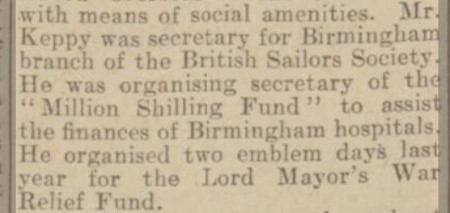
The Evening Despatch of 4 January 1941, also announcing his death, describes him as ‘the driving force’ in these organisations. As an example of his indefatigable efforts, the Birmingham Daily Gazette of 4 November 1930 carries the information
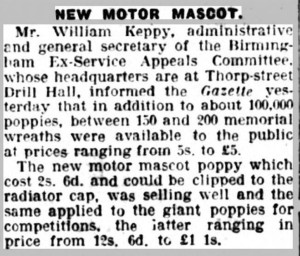
Interesting that, at a time when cars were owned by fewer people, motor mascots were available. Today, car poppies can be bought on line for £5.49. Using a Bank of England conversion rate gives the equivalent cost of about £3 in today’s money for the 1930 car mascot but of course there would be fewer sales of them than there might be today now that we are knee deep in vehicles.
As if all his sterling work for charities were not enough, Mr Keppy was also “prominent in the dance band world” (Birmingham Daily Gazette 06 January 1941). At one point he organised about five bands, including one called the Esmerelda Band. He was both drummer and conductor and the bands made a point of not playing from musical scores. It is possibly one of his dance bands – although not named as such – that entertained at a function of the Warriors’ Club reported by the Tamworth Herald in 1932.
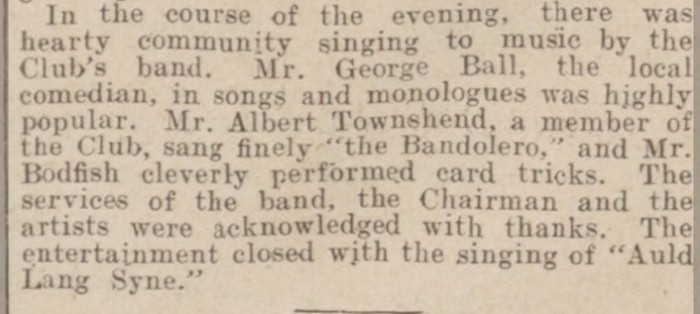
Apart from his being involved in a number of charities and being very proactive in this work, the main reason for all the newspaper reports about Mr Keppy is his untimely death. As the report of his funeral (Birmingham Daily Gazette 8 January 1941) indicated, he left a widow and two daughters, one of whom became a pupil at the School. The second daughter would have been 17 at the time of her father’s death and therefore too old for school.
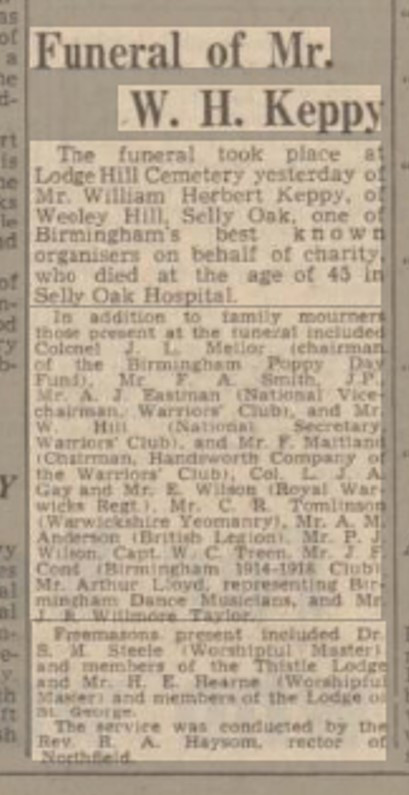
Birmingham Daily Gazette 06 January 1941
Although the majority of his life was spent in the Midlands – apart from a visit to Australia where he first had the idea of a dance band that didn’t play from printed music – William Keppy was actually born in Breconshire in 1895. By 1901, however, he, with his family, was in Smethwick. When he joined the army in 1913, his trade was given as machinist for Phillips. This was J. A. Phillips and Co, manufacturer of bicycles and bicycle components, originally based in Birmingham but which had moved to the Credenda Works in Smethwick in 1908. https://www.gracesguide.co.uk
Mr Keppy was a Freemason and his premature death made his daughter eligible for support from the Freemasons’ Charity. Throughout the School’s history, the death of fathers was often the prime reason for daughters to become pupils, so much so that, during most of the twentieth century, it was quite unusual for a pupil to have a father who was still alive. A pupil who left in the late 1950s wrote to her friend, somewhat tongue in cheek, about her ‘discovery’ of life in the outside world beyond the protective walls of the School: “Mary – a revelation. Some girls have fathers!” The tone may have been facetious but it pointed to the reason why the pupils were known by the locals as ‘the orphans on the hill’.
As his daughter would have been 10 when her father died ‘after a brief illness’ in Selly Oak hospital, she may well have been aware of her father’s involvement in the Poppy Day appeal (although children are generally unaware of what their parents do until they become adults themselves!) and, if so, the Remembrance Day services may well have had a specific poignancy for her both at School and beyond it. Personal connections with anything always heighten one’s awareness of it. Ask the girls who participate in Drill on Remembrance Sunday, who lay their poppies on the floor; ask the trumpeter who plays the Last Post; ask the girls who, as part of the Combined Cadet Force, play an active role in the service; ask the members of Chapel choir who sing for the service; ask … but you get the picture.
The service at School doesn’t just include the girls and their parents, and the members of the Old Masonic Girls’ Association (OMGA) but is shared with the Old Masonians’ Association (OMA) whose school closed in 1977. It is their memorial which forms the centrepiece of the wreath laying, so even greater poignancy in the act of remembrance.
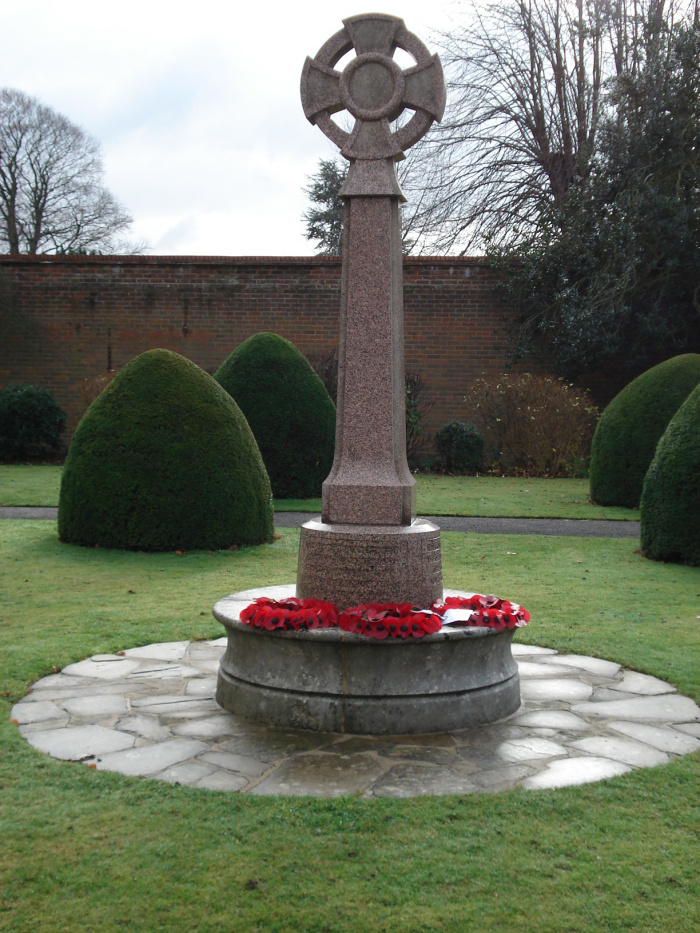
During the two minutes’ silence as part of the service, each person will be remembering differently.
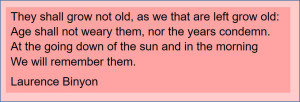
http://www.greatwar.co.uk/poems/laurence-binyon-for-the-fallen.htm
Advertisements Share this:

